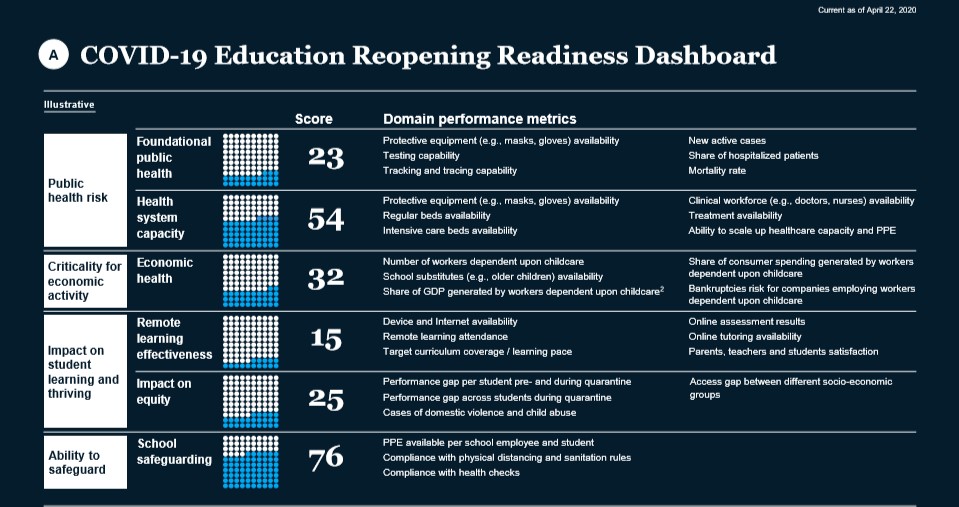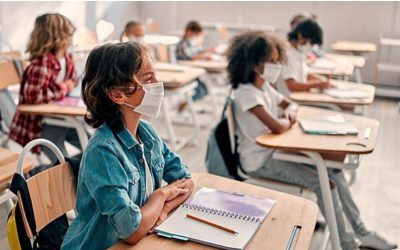COVID-19 and considerations for reopening schools
7 May 2020 | Policy-makers
China, Denmark, Japan, and Norway have recently reopened their schools, while other countries, such as the Netherlands are planning to do so over the next couple of weeks. On April 23rd McKinsey organized a webinar focused on three questions school systems should consider when reopening schools: when to reopen, for whom, and what health and safety measures should be adopted when reopening the schools? This blog summarizes some of our key points and the lessons we learned from the webinar (the original version is here) with further details from our own sourcing of the national and international news.
Prof. Dr. Melanie Ehren & Rukiye Turkeli
07-05-2020


When to reopen? Four topics to consider
McKinsey recently introduced a five-step model of how education systems can plan for moving through the pandemic. The third step considers the reopening of schools and the four interconnecting components that need to be considered
1) Risks to public health
Decision makers will need to determine whether reopening of schools will lead to a resurgence of COVID-19 pandemic among students, school staff, and the broader community. Although children appear to have milder symptoms than adults, the extent to which they transmit the virus is still unclear. Particular concern needs to be given to older and immune-compromised teachers: can they be given different roles with less contact to children? Perhaps they can be in charge of organizing the instructional time table or home support of parents whilst in-school teaching is phased in.
2) Schools’ importance to economic activity
Policy-makers also need to consider the importance of schools in enabling parents to return to fulltime work. Particularly parents/carers with younger children and no alternate caregiver will need childcare and reopening of schools to be able to return to work. Long-time closure of schools will have a knock-on effect on the economy for those countries/regions or areas of the labour market where employees are unable to combine (fulltime) work, child care and homeschooling. If most parents can work remotely while fulfilling childcare responsibilities or have access to alternative childcare (family, friends), schools might be stay closed for longer.
3) Impacts on students’ learning and well-being
Frederic Panier (McKinsey) referred to an ‘’education reopening readiness dashboard’’ to assess the current status of the virus spread, the quality of online teaching, potential learning loss during school closure and concerns over students’ well-being and access to facilities for online learning. Such dashboard should be updated regularly over the next couple of months to decide whether schools can be reopened and stay open for the next two years depending on the COVID-19 pandemic situation.
Figure 1. Example of an Education Reopening Readiness Dashboard with illustrative numbers

Source: McKinsey and Company, Education webinar, 23 April 2020
Given the vital role of schools for children’s’ socio-emotional development and well-being, policy-makers also need to consider how to for example safeguard children from abuse and neglect, and how to feed those who are on free school meals and school-feeding schemes. If school systems are not able to deliver these services out of school, there is more need for a speedier reopening.
4) Safeguarding readiness
The last component decision makers should consider is the ability of schools to implement the necessary measures to ensure the health of staff and students and limit the transmission of the virus. The infrastructure, budget, supply chains, policies, and culture contribute to the ability of compliance and should therefore be taken into account. Countries are best advised to implement monitoring systems to track compliance in schools to social distancing requirements, also taking into account students’ travel to school (e.g. on school buses or public transportation).
Four ways in which to reopen
During the webinar 4 archetypes for when and for whom to reopen schools were illustrated:
1) No reopening at least for the end of the current schoolyear
2) Reopening for certain segments of students: school systems may decide to reopen for (low-income) students who are less likely to have support for remote learning and do not make sufficient progress in learning; vulnerable students (with disabilities, special needs); and children of essential workers;
3) Reopening for targeted levels of education. Reopening only primary schools or secondary schools. Many countries have chosen to reopen secondary schools in the assumption that social distancing is easier to implement for older children.
4) Reopening for targeted years. A few countries (Germany) have considered to reopen grades which have high stakes exams/graduation.
Health and safety issues to consider when reopening
Decision makers need to adopt measures which are effective and optimize learning as well. For example, partially reopening of schools for different groups of student may create inconsistent learning environments or keeping 1,5-meter distance will be difficult for younger students. School systems should evaluate health and safety measures with a view on the physical infrastructure of schools and where schools are located, scheduling and staffing, transportation of students and staff to school, and additional health policies in school:
Physical infrastructure
Different examples of ways to restructure the school building to minimize spread of the virus were presented: more hand washing stations, physical reconstruction of classrooms, floor marking, designated entrances, reducing physical contact points.
Scheduling and staffing
During the webinar is was recommended to divide students into cohort to minimize physical contact, rather than part time schedules since these schedules also reduce instructional time and affect students` learning. In reopening schools, consideration also needs to be given to teachers and wider school staff and whether they are willing and able to come into contact with students again. Teachers who are at a higher risk of developing COVID-19 can be better served working at home and providing remote instruction to students who (still) receive remote learning.
Transportation
How are students and staff travelling to school? In some countries, students are bused into school and this requires alternative travel arrangements to allow for social distancing, such as by increasing the number of bus journeys to reduce the number of students per bus, or organizing routes by cohort. These however have cost implications as they require more drivers, funding, and sanitization between routes.
Health policies
School systems must consider which health and behavioral policies, such as checking temperature and wearing masks, are feasible to implement. Quarantine of students who have a fever is a good measure to prevent virus spread, but will only be relevant when schools have sufficient coronavirus tests to decide on whether peers or the entire school needs to be sent home. Other measures to implement are a frequent schedule of handwashing and sanitation, deep and frequent cleaning of surfaces after each school day. To allow sick students and staff to stay at home, student attendance policies and staff sick leave policies need to be relaxed when these would penalize students and teachers for not coming to school
Finally, school systems should investigate the willingness and readiness of parents, students and teachers to return to school. Frequent communication about the health and safety measures taken (e.g. clearly communicating how often the school requires students to wash hands, how often the school is cleaned, how the school enforces social distancing) can build staff, parents, students, and communities’ confidence that the school is a sufficiently safe place to come to and ensure their willingness to return.
See also information for:
Most recent blogs:
How LEARN! supports primary and secondary schools in mapping social-emotional functioning and well-being for the school scan of the National Education Program
Jun 28, 2021
Extra support, catch-up programmes, learning delays, these have now become common terms in...
Conference ‘Increasing educational opportunities in the wake of Covid-19’
Jun 21, 2021
Covid-19 has an enormous impact on education. This has led to an increased interest in how recent...
Educational opportunities in the wake of COVID-19: webinars now available on Youtube
Jun 17, 2021
On the 9th of June LEARN! and Educationlab organized an online conference about...
Homeschooling during the COVID-19 pandemic: Parental experiences, risk and resilience
Apr 1, 2021
Lockdown measures and school closures due to the COVID-19 pandemic meant that families with...
Catch-up and support programmes in primary and secondary education
Mar 1, 2021
The Ministry of Education, Culture and Science (OCW) provides funding in three application rounds...
Home education with adaptive practice software: gains instead of losses?
Jan 26, 2021
As schools all over Europe remain shuttered for the second time this winter because of the Covid...





